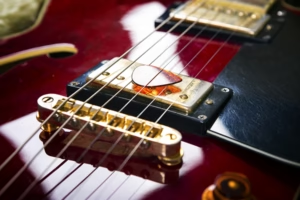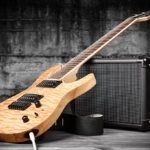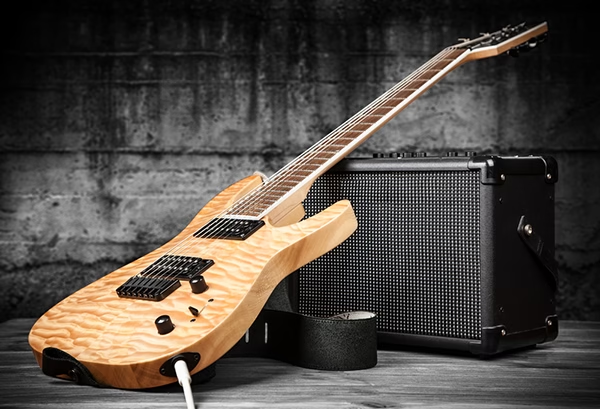1. Understanding the Role of Guitar Bridges
Every guitarist knows tone starts at the strings—but few realize how deeply the guitar bridge shapes that sound. The bridge anchors the strings to the body, transferring vibration and controlling sustain, resonance, and tuning. From tremolo systems to fixed bridges, the type of bridge you choose affects everything from feel to maintenance.
A well-designed guitar bridge maintains proper string height, scale length, and intonation. Poor bridge quality or installation can cause tuning instability, dead spots, or poor sustain. Whether you play blues, rock, or metal, your bridge choice defines how your instrument responds.
2. Fixed Bridges: The Foundation of Stability
Fixed bridges—like the Tune-O-Matic and hardtail—are prized for their simplicity and sustain. Because they lack moving parts, these guitar bridges provide solid tuning stability.
Popular on Les Pauls and PRS guitars, fixed bridges allow each saddle to be adjusted for precise intonation.
Advantages:
-
Excellent tuning reliability
-
Greater sustain due to direct body contact
-
Easy string changes and setup
Fixed bridges are ideal for rhythm players or anyone who values consistency over movement. Synonyms like hardtail bridge or non-tremolo bridge are often used interchangeably.
3. Tremolo Bridges: Flexibility and Expression
Also known as vibrato bridges, these systems allow pitch modulation by moving the bridge plate or tailpiece. The guitar bridge in this category offers expressive bends and dive-bombs used by legends like Hendrix and Van Halen.
Types include:
-
Synchronized tremolo: Found on Stratocasters; balances spring tension and string pull.
-
Bigsby tremolo: Vintage-style vibrato with smooth, subtle motion.
-
Floyd Rose locking system: Famous for dive-bombs and rock-solid return-to-pitch accuracy.
Each style delivers unique tonal dynamics. The Floyd Rose bridge, for instance, locks the strings at both the nut and bridge to eliminate slippage during extreme motion.
4. Acoustic Guitar Bridges: Tradition Meets Function
On acoustic instruments, the guitar bridge has a dual role: transmitting vibration and supporting the saddle. Usually made from rosewood or ebony, acoustic bridges glue directly onto the soundboard.
Key components:
-
Bridge plate: Reinforces the top from beneath.
-
Saddle: Determines action height and intonation.
-
Bridge pins: Secure the strings to the body.
An acoustic guitar bridge dramatically influences tonal warmth and projection. A poorly fitted bridge can dampen resonance or even cause structural damage over time.
5. Bass Guitar Bridges: Anchoring Deep Frequencies
Bass players demand power and sustain—and their bridges deliver it. Bass guitar bridges come in high-mass or standard forms, with materials like brass or steel enhancing low-end punch.
Popular designs:
-
Bent plate bridges (vintage Fender style): Bright and open tone.
-
High-mass bridges (Badass, Hipshot): Thick sustain and focus.
Modern adjustable bass guitar bridges also allow string spacing tweaks for personal comfort and control, crucial for slappers and fingerstyle players alike.
6. Materials and Build: How Bridges Shape Sound
Bridge construction materials are as important as design. A guitar bridge made from brass or steel offers brightness and clarity, while aluminum enhances resonance and warmth. Titanium bridges, though expensive, balance sustain with articulate tone.
Common materials:
-
Brass: Warm and resonant
-
Steel: Bright and cutting
-
Zinc alloys: Cost-effective and consistent
-
Titanium: Lightweight and acoustically transparent
Even small changes—like swapping saddles—can transform tone. Upgrading your guitar bridge is one of the most effective hardware modifications for tone improvement.
7. Choosing the Right Bridge for Your Playing Style
When selecting a guitar bridge, consider your genre, technique, and maintenance preferences.
-
Rock/Metal: A Floyd Rose tremolo or high-mass hardtail suits aggressive bends and sustain.
-
Blues/Jazz: A Tune-O-Matic bridge offers warm tone and smooth string feel.
-
Acoustic: Stick with bone or Tusq saddles for natural resonance.
If you perform frequent string bends or vibrato techniques, a tremolo bridge offers expressive depth. For recording or studio work, fixed bridges deliver consistent tone and tuning precision.
The ideal guitar bridge should feel natural under your picking hand and complement your tonal goals.
8. Maintenance and Troubleshooting Tips
To keep your guitar bridge performing flawlessly, regular maintenance is essential:
-
Clean metal parts with microfiber and mild polish.
-
Lubricate moving pivots to prevent friction wear.
-
Check intonation every few months, especially with string gauge changes.
-
Inspect mounting screws and springs on tremolos for corrosion.
A misaligned bridge saddle can cause buzzing or uneven tone. In that case, realign saddles using a tuner and feeler gauge for accurate setup.
9. Innovations and Future Trends in Bridge Design
Modern luthiers continually reinvent the guitar bridge for tone optimization and comfort. Cutting-edge designs like Evertune bridges maintain perfect tuning stability, even under temperature shifts. Piezo bridges integrate acoustic-like tones into electric guitars, opening hybrid possibilities.
Trends to watch:
-
3D-printed titanium bridges for ultra-light resonance
-
Active bridge sensors for real-time performance monitoring
-
Modular bridge systems for quick string swaps
As technology evolves, the humble guitar bridge remains central to innovation, blending tradition with engineering.
10. Final Thoughts: The Heartbeat of Your Tone
A guitar bridge isn’t just a structural component—it’s the soul of your instrument’s sound. From acoustic subtleties to metal mayhem, your bridge defines how your music feels and flows. Whether you prefer the rock-solid reliability of a hardtail or the expressive shimmer of a tremolo, understanding and choosing the right guitar bridge unlocks your instrument’s full potential.







